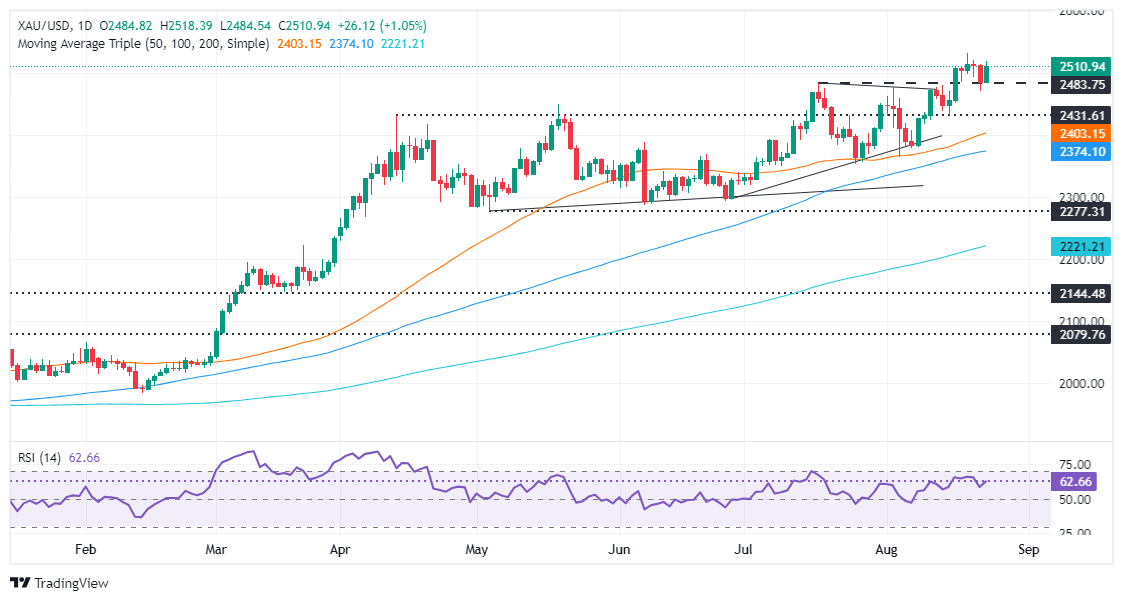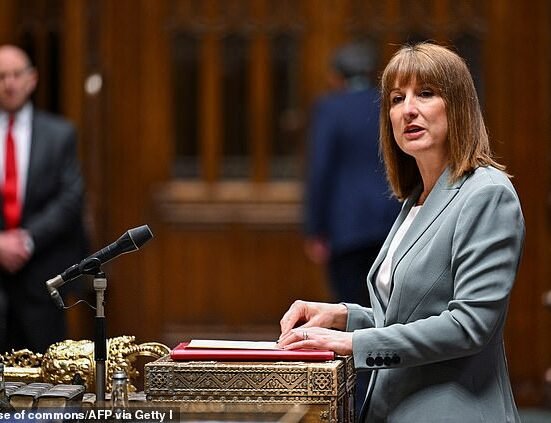- Gold prices jump over 1% after Fed Chair Powell hints at upcoming rate cuts, expressing confidence in inflation nearing the 2% target.
- The US Dollar Index (DXY) falls 0.82% to 100.68, as Powell’s remarks push traders to bet on a 50 bps rate cut in September.
- US 10-year Treasury yields drop five basis points to 3.80%, supporting bullion’s rise, as market eyes the August Nonfarm Payrolls report for further guidance.
Gold price edges up over 1% on Friday as the Greenback and US Treasury bond yields dive following dovish remarks from Federal Reserve Chair Jerome Powell, who signaled he’s confident that inflation is edging towards the 2% goal and that rates should be cut. The XAU/USD trades at $2510 after bouncing off daily lows of $2484.
Bullion prices rose sharply as Powell said, “The time has come for policy to adjust. ” He acknowledged that inflation is on the path to 2% and expressed that the Fed has shifted towards achieving the maximum employment mandate.
After those remarks, Gold reclaimed the $2500 figure, and the Greenback extended its losses. The US Dollar Index (DXY), which measures the dollar’s performance against a basket of six currencies, dropped 0.82% and traded at 100.68.
US Treasury bond yields immediately dropped, with the US 10-year benchmark note slumping five basis points to 3.80%. Traders increased their bets that the Fed would cut rates by 50 bps at the September meeting.
The CME FedWatch Tool shows that market participants had fully priced in a 25 bps cut, while odds for a larger size stand at 36.5%, up from 24% a day ago.
Now, with the Fed shifting towards the jobs market, the August Nonfarm Payrolls report would be the last piece of the puzzle to determine the size of the cut.
Daily digest market movers: Gold price advances ahead of next week’s US inflation report
- If US economic data continues to be soft, the Gold price uptrend will remain, which would increase speculation about a big-size rate cut.
- After Powell’s speech, other Fed officials made notable comments. Philadelphia Fed President Patrick Harker stated that the Fed needs to lower rates methodically. Chicago Fed President Austan Goolsbee added that monetary policy is currently at its most restrictive level, and the Fed’s focus is now shifting toward achieving its employment mandate.
- Next week, the US economic docket will feature Durable Goods Orders, the Conference Board (CB) Consumer Confidence index, Initial Jobless Claims data for the week ending August 24, and the Fed’s favorite inflation gauge, the Core Personal Consumption Expenditures (PCE) Price Index.
- Additionally, Fed speakers led by Christopher Waller and Atlanta’s Fed President Raphael Bostic would cross the wires to prepare the ground ahead of the September meeting.
Technical outlook: Gold’s uptrend intact as buyers eye $2,550
Gold’s uptrend remains intact and might extend if buyers lift prices above the all-time high (ATH) of $2,531. A breach of the latter will expose the $2,550 mark, followed by the $2,600 mark.
On the flip side, if Gold achieves a daily close below $2,500, a re-test of the previous all-time high (ATH) of $2,483 is on the cards. If surpassed, Gold’s next support would be the May 20 peak of $2,450, followed by the 50-day Simple Moving Average (SMA) at $2,402.
Fed FAQs
Monetary policy in the US is shaped by the Federal Reserve (Fed). The Fed has two mandates: to achieve price stability and foster full employment. Its primary tool to achieve these goals is by adjusting interest rates. When prices are rising too quickly and inflation is above the Fed’s 2% target, it raises interest rates, increasing borrowing costs throughout the economy. This results in a stronger US Dollar (USD) as it makes the US a more attractive place for international investors to park their money. When inflation falls below 2% or the Unemployment Rate is too high, the Fed may lower interest rates to encourage borrowing, which weighs on the Greenback.
The Federal Reserve (Fed) holds eight policy meetings a year, where the Federal Open Market Committee (FOMC) assesses economic conditions and makes monetary policy decisions. The FOMC is attended by twelve Fed officials – the seven members of the Board of Governors, the president of the Federal Reserve Bank of New York, and four of the remaining eleven regional Reserve Bank presidents, who serve one-year terms on a rotating basis.
In extreme situations, the Federal Reserve may resort to a policy named Quantitative Easing (QE). QE is the process by which the Fed substantially increases the flow of credit in a stuck financial system. It is a non-standard policy measure used during crises or when inflation is extremely low. It was the Fed’s weapon of choice during the Great Financial Crisis in 2008. It involves the Fed printing more Dollars and using them to buy high grade bonds from financial institutions. QE usually weakens the US Dollar.
Quantitative tightening (QT) is the reverse process of QE, whereby the Federal Reserve stops buying bonds from financial institutions and does not reinvest the principal from the bonds it holds maturing, to purchase new bonds. It is usually positive for the value of the US Dollar.








